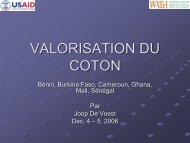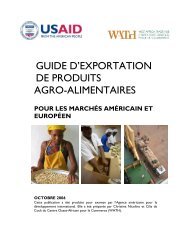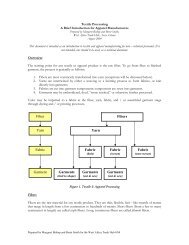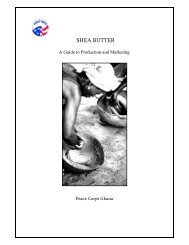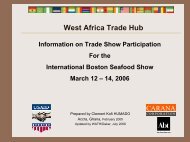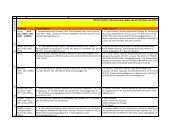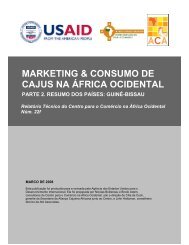A Value Chain Analysis of the Cashew Sector - AGOA Export Toolkit
A Value Chain Analysis of the Cashew Sector - AGOA Export Toolkit
A Value Chain Analysis of the Cashew Sector - AGOA Export Toolkit
Create successful ePaper yourself
Turn your PDF publications into a flip-book with our unique Google optimized e-Paper software.
8<br />
Executive Summary<br />
Agriculture is <strong>the</strong> predominant sector in Ghana’s economy. In 2008, agricultural activities contributed<br />
to 33.6% <strong>of</strong> Gross Domestic Product (GDP), employed about 60% <strong>of</strong> <strong>the</strong> labour force, and accounted<br />
for 54% <strong>of</strong> foreign exchange earnings (Ghana Statistical Service, 2008). Th e sector itself is compo sed<br />
<strong>of</strong> fi ve subsectors, namely crops o<strong>the</strong>r than cocoa, cocoa, livestock, fi sheries and forestry. However,<br />
non-traditional crops, such as pineapple, mango and cashew nuts, are increasingly <strong>of</strong> importance<br />
to <strong>the</strong> Ghanaian economy.<br />
During <strong>the</strong> last six years, <strong>the</strong>re has been growing interest in cashew cultivation in Ghana because<br />
<strong>of</strong> its importance to farm families, coupled with high demand and a fl ourishing export market. Production<br />
is mostly carried out by smallholder farmers (88%), who are usually organised into associations.<br />
Most <strong>of</strong> <strong>the</strong>se producers rely on family labour or hired labour, especially for weeding and harvesting<br />
activities. Since cashew is harvested during <strong>the</strong> lean season for all major staples (e.g. maize, yam, plantain<br />
and millet), this crop could help avoid food purchases and contribute to increased food security.<br />
Th e Ghana <strong>Cashew</strong> Industry Study conducted by <strong>the</strong> Ministry <strong>of</strong> Food and Agriculture (MOFA)<br />
in 1998 estimated that Ghana has enough land to develop new plantations <strong>of</strong> about 60,000 ha by 2008<br />
and up to 100,000 ha by 2020. However, <strong>the</strong>re are strong doubts about <strong>the</strong> credibility <strong>of</strong> <strong>the</strong>se fi gures<br />
due to generally lacking resources (such as land and water), <strong>the</strong> competition for resources arising from<br />
<strong>the</strong> production <strong>of</strong> o<strong>the</strong>r food and cash crops, and <strong>the</strong> possible negative impact on (agro-) biodiversity.<br />
In 2008, 61,590 t <strong>of</strong> raw cashew nuts (RCN) valued at US$ 45.37 million were exported for processing,<br />
mainly to India, while annual local production was estimated to be 26,454 t. Th ese numbers indicate<br />
cross border trading <strong>of</strong> RCN between Ghana and neighbouring countries, especially Côte d’Ivoire.<br />
In 2008, RCN exports contributed to 6.1% <strong>of</strong> GDP and 18.2% <strong>of</strong> agricultural GDP (computed according<br />
to data available from <strong>the</strong> Ghana Shippers’ Council and <strong>the</strong> Ghana Statistical Service).



